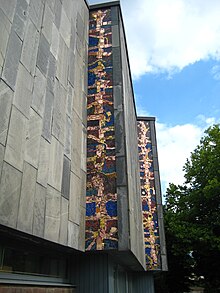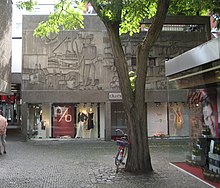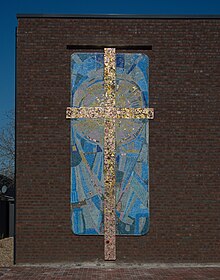Georg Schmidt-Westerstede
Georg Schmidt-Westerstede (born April 23, 1921 in Wilhelmshaven ; † January 12, 1982 in Oldenburg ) was a German painter and graphic artist. The focus of his wide-ranging work was art in architecture .
life and work
Franz Georg Schmidt grew up in Westerstede , where he first learned the painting trade. After a war injury (leg amputation) he turned to free painting and drawing. In 1947 he was the youngest founding member of the BBK in Oldenburg. He learned in the free painting class of Gustav-Adolf Schreiber at the Nordic Art Academy in Bremen . After two semesters and starting a family, the financial means were no longer sufficient to continue studying. He established himself as a freelance artist in Oldenburg and from then on called himself “Georg Schmidt-Westerstede” because of his ties to his home town. He was temporarily active as a draftsman for the Nordwest-Zeitung and other local newspapers.
In spring 1953 he went on a study trip to Paris , together with the painter and art critic Rolf Höfer. There he took courses at the Académie de la Grande Chaumière . A second stay in Paris followed in autumn together with the painter Max Herrmann .
1953 was shown in the Wilhelmshaven art association Georg Schmidt-Westerstede's first exhibition. In 1956 he took part in an exhibition at the BBK in Hanover. He used a travel grant from the Oldenburger Kunstverein for trips to Genoa and Murmansk . The works of the fellows were shown in 1957 in the Oldenburg State Museum for Art and Cultural History . After that he only rarely took part in exhibitions, and when he did, he often did designs for art in buildings. These are considered autonomous works of art.
From the mid-1970s, Georg Schmidt-Westerstede turned back to painting more intensively and increased the level of abstraction. He was represented in 1980 with four works from this creative period at a joint exhibition by Oldenburg artists in the Danish sponsored town of Tåstrup.
The passionate sailor Georg Schmidt-Westerstede crossed the Atlantic together with three friends on his motor sailer Lang Lütjen. During a sailing trip in 1980 he suffered a serious accident in Scotland. He never recovered from the physical and psychological injuries. He passed away voluntarily on January 12, 1982.
Oil paintings and watercolors are shown in large numbers on his website. His graphic work includes in particular pen drawings with predominantly regional motifs, the prints of which were published in folders.
architectural art
In Georg Schmidt-Westerstede's life's work, building art took the dominant position. She challenged him again and again from the 1950s until his death and secured him and his family a livelihood. The catalog raisonné of this creative complex comprises almost five hundred objects.
Georg Schmidt-Westerstede used a variety of techniques and artistic forms of expression within art in architecture. He mastered the handling of very different materials. From 1950 onwards, large-format wall paintings and sgraffiti as well as reliefs made of band iron were created. Its glass mosaics are of particular importance . Relief walls made of clinker brick or concrete were created according to his designs, some with inlays made of glass mosaic; furthermore, bas-reliefs made of cast bronze or light metal and slate; likewise sculptures made of bronze, concrete and glass as well as leaded glass windows .
In addition, he worked as a color consultant u. a. active for the city of Oldenburg. Entire streets, schools and public buildings were colored according to his designs. Due to his geometrizing and color design of large-scale facades of factory and warehouse halls, which was designed towards the end of the 1970s, the architecture of the building appears less expansive and more harmonious in overall appearance.
Glass mosaics
Georg Schmidt-Westerstede's work has shaped the cityscape through the large number of glass mosaics. Here he took up an elaborate historical technique that goes back to Roman antiquity and which he also knew how to carry out by hand. While he initially used pre-broken stones, from 1959 he cut them himself from larger panes of solid-colored glass (smalts) and laid them in a freely rhythmic manner. The glasses came from workshops in Darmstadt and Murano .
In contrast to antiquity and the early Middle Ages, he did not place the stones directly in the bed of mortar, but glued them on the floor of his studio the wrong way round on tracing paper. The finished mosaic was then broken down into partial areas and placed in a prepared mortar bed at the destination. After removing the tracing paper, the mosaic was grouted. This resulted in large-scale glass mosaics of up to 30 m² with approx. 4,000 to 5,000 stones per m², all of which were laid individually by hand.
Selected works on art in architecture
- 1952: Two sgraffiti in the clubhouse of the Oldenburg Rowing Club (ORVO).
- 1956: First glass mosaic in the (then) new employment office in Oldenburg.
- 1962: Glass mosaic "The water cycle", waterworks of the city of Oldenburg, Hatten-Sandkrug.
- 1962: lead glass window (no longer available) and three glass mosaics, Nordenham vocational school .
- 1962: Glass mosaic in the entrance area of the Landessparkasse zu Oldenburg. Rescued when the building was demolished, since 2010 on the 1st floor of the Oldenburg Higher Regional Court.
- 1962/1963: Three glass mosaics and nine leaded glass windows on the grounds of the Henning von Tresckow barracks, Oldenburg.
- 1964: Four glass mosaics with maritime motifs on apartment buildings in Wilhelmshaven, Hermann-Ehlers-Str. (3) and Zedeliusstraße.
- 1964: Glass mosaic at the indoor swimming pool in Wiesmoor .
- 1968: Three glass mosaic friezes in the facade of the Oldenburg City Museum .
- 1968: Glass mosaic for the chancel of the New Apostolic Church Westerstede, since 2019 on the facade of the new church of the congregation.
- 1968: Execution of a glass mosaic based on designs by Dr. Heinrich Schwarz, installation at the Hygiene Institute in Lomé , Togo.
- 1968: Relief wall made of concrete with inlays made of glass mosaic, naval base Wilhelmshaven.
- 1969: Relief wall made of concrete "Development of shipping on the Weser from the Hanseatic League to modern times", Brake- Kirchhammelwarden .
- 1972: Relief wall made of concrete with inlays of glass mosaic, British High School, Rinteln .
- 1975: Relief wall made of clinker bricks, school at Bürgerbusch (Eßkamp), Oldenburg.
- 1976: Multi-part bas-relief made of cast light metal "The flight to light", on the facade of the Gertrudenheim, Oldenburg.
- 1977: The last glass mosaic "The Four Elements", in the stairwell of the former health department of the city of Oldenburg (Rummelweg).
- 1977: Facade design of the Oldenburgische Glashütte (no longer available).
- 1978: Fountain sculpture with relief panels made of cast bronze, Oldenburg tax office. Since 2017 in front of the entrance to the new tax office (Stubbenweg).
- 1979: Facade design of a high-bay warehouse, Westerstede.
- 1979: Three reliefs made of light metal cast, Montanus Clinic Bad Schwalbach .
- 1980: Five concrete relief walls, "Siel's working place from the sea to the Haaren", boundary walls to the harbor basin at the confluence of the Haaren into the Hunte , Oldenburg.
- 1980: Sculpture "Wegweiser" made of concrete with inlays made of colored thick glass, Customs Office Brake .
- 1981: Relief wall made of clinker bricks with motifs from the city of Emden, at the Emden police station .
- 1982: Relief wall made of clinker bricks, Lüneburg administrative center (completed posthumously).
Herbartgang total work of art
The Herbartgang is a passage in Oldenburg's pedestrian zone and is considered a "monument to pedestrianization, the importance of which today should extend far beyond Oldenburg". The initiator and investor Georg Hanßmann had the idea that the Herbartgang should be created from a single source as architecture and art. He named Bremer Böttcherstraße as a concrete suggestion for the basic concept. Even at the project stage, Hanßmann brought his friend Georg Schmidt-Westerstede to his side as an artistic advisor. The planning group was completed by the Oldenburg architects Hans Latta and Hans Joachim Hölscher, who won the competition. The first construction phases were realized in the years 1961–1963.
Georg Schmidt-Westerstede is represented in the Herbartgang with the following works:
- Horizontal light band with mosaics made of colored glass, 1963.
- Vertical light band with mosaics made of colored glass, which shows the ground plan of the Hertbartganges (no longer available).
- Cast bronze door handles with glass mosaic coverings, originally at least 14 pieces, 1963–1966.
- Concrete relief "Merkur / Alter und neue Handel", 1965.
- Glass mosaic "bowling" in the stairwell of the former bowling alley of a restaurant, 1965.
- Glass mosaic "Bottles and jugs" in the wine cellar of a restaurant, 1968.
- Glass mosaic "Wave play" in an inaccessible swimming pool, 1971.
- Relief wall made of clinker bricks on the rear facade of a restaurant, 1978.
- Glass mosaic in the conference area of a hotel, created in 1972, installed posthumously in 2004.
The Herbartgang total work of art is completed by two fountains by the sculptor Anna Maria Strackerjan (courtyard 1 and courtyard 2) as well as a water sculpture made of lava stone and concrete (courtyard 3) and a bronze sculpture (entrance Lange Str.) By the sculptor Udo Reimann .
Preservation
The demolition of a building often means the end of the work of art associated with it. In this way, works by Georg Schmidt-Westerstede have already been lost.
In some cases, however, glass mosaics could be saved. Funders were repeatedly found to finance the complex work. This confirms the great importance of these unique works by Georg Schmidt-Westerstede that have shaped the region.
In the DRK kindergarten in Westerstede, in the Fortmann bank and in the Pius Hospital in Oldenburg, entire walls were implemented to preserve the glass mosaics. A wall with a glass mosaic that was recovered from an office building in 1988 was reinstalled in 2007 at the town hall of Westerstede. Syrian artist Rodi Khalil put the fragments of a glass mosaic that had been chipped off and thus destroyed from an apartment building during thermal insulation work. The reconstructed plant found a new location in 2010 at the Westerstede District Court.
Three more glass mosaics by Georg Schmidt-Westerstede were successfully salvaged from buildings intended for demolition. The mosaicist and graduate designer Klaus-Peter Dyroff and his daughter, the graduate mosaicist Anna Dyroff, removed them from the supporting wall over a large area, put them back together on a solid base and installed them at the new destination. The glass mosaic with the included coat of arms of the Oldenburger Land moved in 2010 from the foyer of the Landessparkasse zu Oldenburg (LzO) to the Oldenburg Higher Regional Court . The glass mosaic with the escape motif "From East Prussia to Oldenburger Land" from the canteen of a wholesale market in Metjendorf was added to the foyer of a care center in Westerstede in 2016. The large glass mosaic with a cross from the chancel of the old New Apostolic Church in Westerstede has been on the facade of the new church of the congregation since 2019.
The ten-ton fountain sculpture in front of the tax office moved in 2017 from the edge of Oldenburg's inner city together with the authority to the north of the city.
literature
- Foundation for Art and Culture in the City of Westerstede (Ed.): Georg Schmidt-Westerstede - Retrospective, monograph with catalog raisonné (Publications of the City Museum Oldenburg; Vol. 33). Isensee-Verlag, Oldenburg 1998, ISBN 3-89598-516-3 .
- Georg Hanßmann: Lang Lütjen on a long journey. Holzberg-Verlag, Oldenburg 1973, ISBN 3-87358-063-2 .
- Monika Schnetkamp (Ed.): Herbartgang Oldenburg - Festschrift for the 55th anniversary of the Herbartgang . Isensee-Verlag, Oldenburg 2016, ISBN 978-3-89995-886-7 .
Web links
The writer Mirko Bonné came across Georg Schmidt-Westerstede's works on his literary shore excursion through the Oldenburger Land in 2019 and reported about it in his blog: Landgang, the twelfth shore leave, the fourteenth
Individual evidence
- ^ Ewald Gäßler: Biographical data on Georg Schmidt-Westerstede . In: Retrospective ..., p. 7
- ^ Jörg Michael Henneberg: Georg Schmidt-Westerstede - The painter. In: Retrospective ..., p. 27
- ^ Ewald Gäßler: Biographical data on Georg Schmidt-Westerstede . In: Retrospective ..., p. 9
- ^ Jörg Michael Henneberg: Georg Schmidt-Westerstede - The painter. In: Retrospective ..., p. 60.
- ^ City of Oldenburg, Department of Culture (ed.): Oldenburg artists in Tåstrup. Oldenburg 1980, p. 33.
- ^ A b Jörg-Michael Henneberg: Georg Schmidt-Westerstede and art in architecture. In: Retrospective ..., p. 104
- ^ Jörg-Michael Henneberg: Georg Schmidt-Westerstede and the art of building. In: Retrospective ..., p. 100
- ↑ Achim Wendt: Vision and History - 55 Years Herbartgang in Oldenburg . In: Herbartgang ..., p. 57.
- ↑ (dei): "A real gem" in the heart of the city. In: Nordwest-Zeitung (NWZ) of October 8, 1970
- ↑ Manfred Hylla: retrospect . In: Retrospective ... p. 156
- ↑ (HD): Old principles in the new house . In: NWZ of March 15, 1990
- ↑ Kerstin Schumann: Mosaic fish are allowed to swim. In: NWZ (Ammerland edition) of December 7, 2007
- ↑ Kerstin Schumann: Puzzle work with colored glass. In: NWZ (Ammerland edition) from May 23, 2009
- ↑ Kerstin Schumann: New location a stroke of luck. In: NWZ (Ammerland edition) of August 10, 2010
- ↑ Sabine Schicke: Glass mosaic now adorns the foyer in the court. In: NWZ of October 16, 2010
- ↑ (EDR): Old glass mosaic saved from destruction. In: NWZ (Ammerland edition) of October 10, 2016
- ↑ Kerstin Schumann: Eye-catcher on Kuhlenstrasse In: NWZ (Ammerland edition) of October 17, 2019
- ↑ Karsten Röhr: A completely new perspective for 300 employees. In: NWZ of February 7, 2017
| personal data | |
|---|---|
| SURNAME | Schmidt-Westerstede, Georg |
| BRIEF DESCRIPTION | German painter and graphic artist |
| DATE OF BIRTH | April 23, 1921 |
| PLACE OF BIRTH | Wilhelmshaven |
| DATE OF DEATH | January 12, 1982 |
| Place of death | Oldenburg |







